20 Beautiful Small Towns in Italy
This website uses affiliate links which may earn a commission at no additional cost to you. As an Amazon Associate I earn from qualifying purchases.
Updated: 19th February 2024
Italy is the stuff of oversized travel legends: gladiator battles in Roman arenas, gondolas gliding along Venetian canals, and communities frozen in time by fierce volcanoes. Yet, the nation’s true magic is often found in one of Italy’s small towns rather than the cohort of star-studded cities.
Deciding which of Italy’s most beautiful towns to visit is as challenging as choosing a gelato flavour. From hilltop townlets framed by saw-toothed peaks to pretty coastal settlements necklaced by the shimmering Adriatic shoreline, the options are delicious from top to toe.
Whether you’re seeking silence among the vines of a hinterland hideaway or would prefer to relish Italy’s best local experiences, these are some of my favourite small Italian towns to visit. Unlike other articles that might spotlight lesser-known (and certainly beautiful) cities, such as Matera and Mantua, my twenty picks are true Italian towns without a single city in sight.
Taormina, Sicily
On Sicily’s seductive east coast, the bewitching hilltop town of Taormina observes the Ionian Sea from high above. The Greeks sure picked a cinematic spot to set up camp some 2000 years ago – something the Romans clearly agreed on when they upgraded the impressive open-air theatre. You don’t even need a script to make these terraced seats the best in the house; the dazzling comma-shaped bay backed by foreboding Mount Etna is the daily performance.
Yet Taormina is as much about modern luxury as historic architectural feats, and if you’re seeking a slice of Sicilian indulgence, you’re in the right place. This is, after all, the main filming location of The White Lotus. Home to some of the most indulgent five star resorts in Italy, a treat-yourself hilltop retreat is Taormina’s grand finale. Better still, settle yourself at the base of the pretty town, and you’ll have the Bay of Taormina on your doorstep. Waking up at the Mazzarò Sea Palace and effortlessly stepping onto Sicily’s swarthy sands is a top-notch ticket, one that makes the uphill schlep to the town itself worthwhile.

Read more:
Reasons to visit Sicily
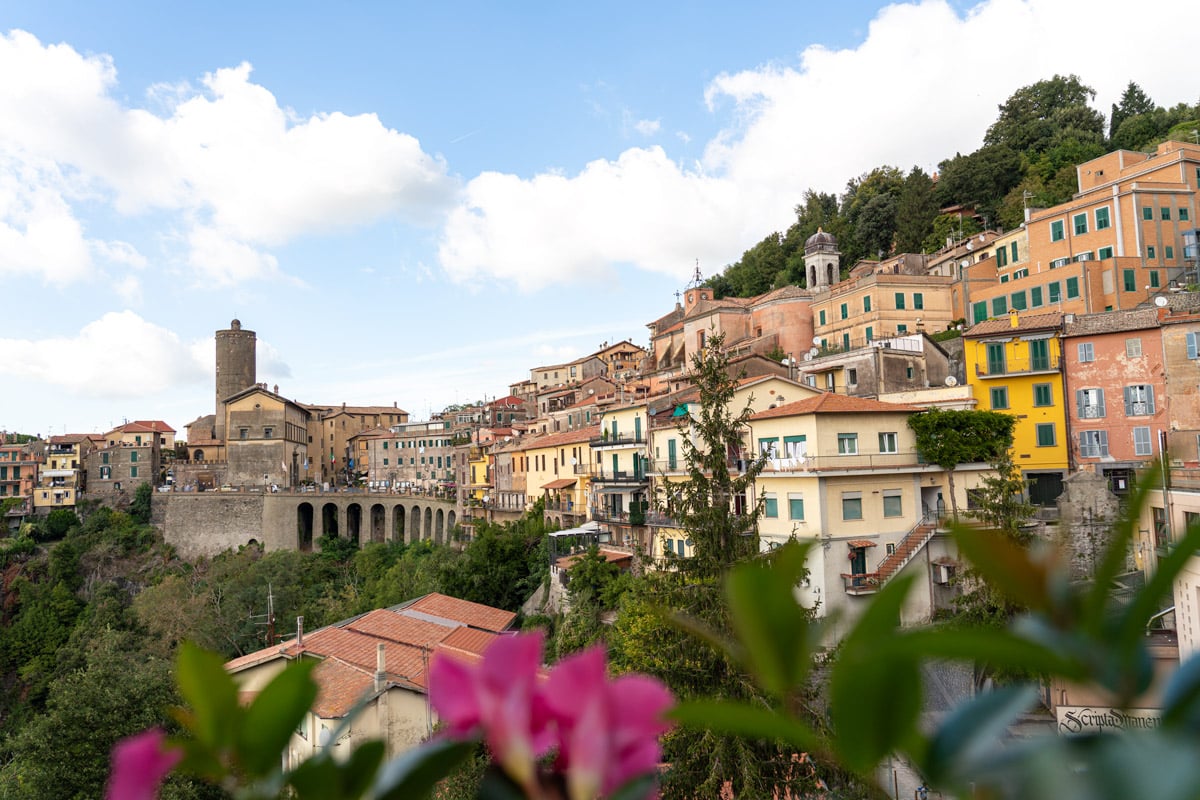
Nemi, Lazio
Castel Gandolfo is one of Italy’s most famous towns to visit on a day trip from Rome. Thousands have flocked through the imposing doors of the Pope’s palace since he gave up his summer residence for tourists. Venture just a little further, and the idyllic small town of Nemi has much the same charm but with far fewer crowds. A splendid shaded trail under chestnut trees links the pretty pair. Once in Nemi, you’ll be greeted by a cute, compact and pedestrianised core. Narrow streets link pastel-hued homes, far-reaching viewpoints, and cafes selling the town’s signature dish, porchetta (pork) sandwiches.
Like Castel Gandolfo, which crowns Lake Albano, a volcanic crater, Nemi is also perched above a dazzling body of water. Not just a serene spot for kayaking alongside ducks, some of Nemi’s best attractions are found bankside: The Temple of Diana, a significant pilgrimage site since the 6th century BC, and the Roman Ship Museum of Nemi. The latter houses the artefacts and recreations of ancient Roman wooden ships, which amazingly survived for centuries at the bottom of the lake, only for a fire to destroy the museum in the 1940s. If you’re looking to tack on some small Italian towns to your Rome visit, Nemi and Castel Gandolfo are the perfect pair.
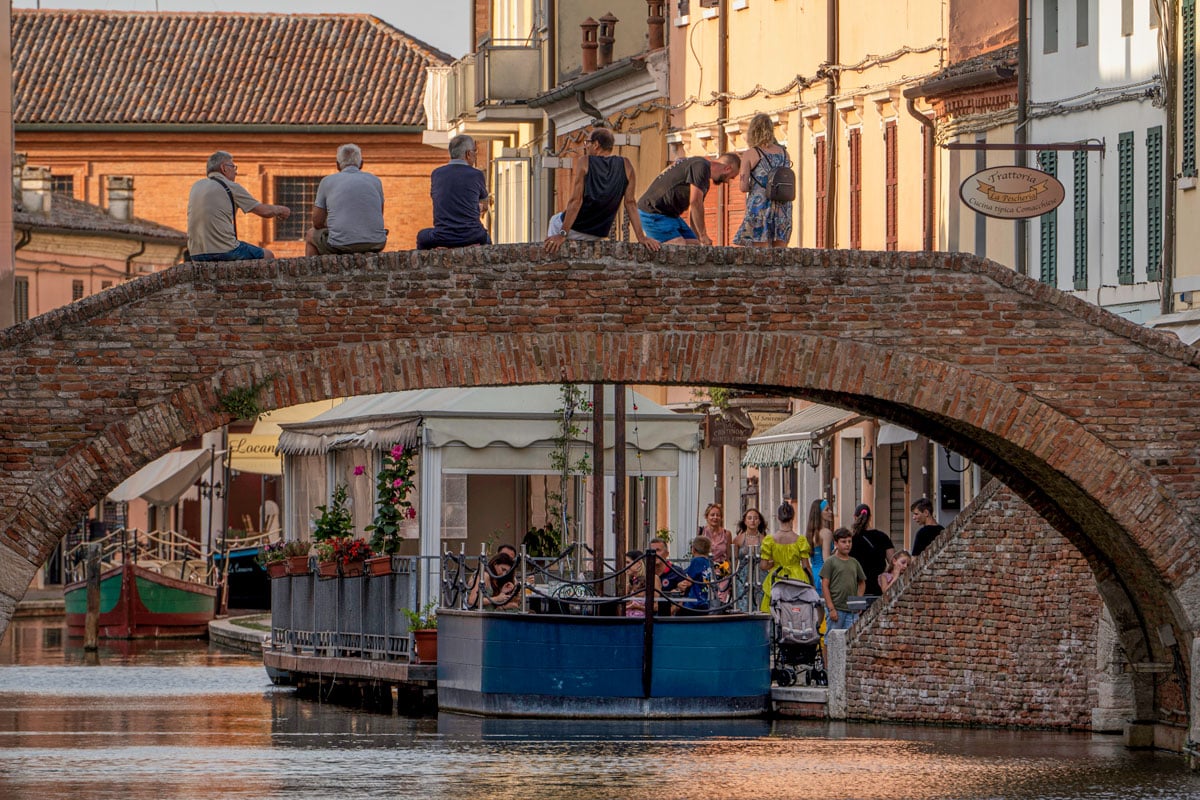
Comacchio, Emilia Romagna
Wedged between the flamingo-frequented wetlands of the Po Delta and the beaches of the Emilia Romagna Riviera, the former fishing village of Comacchio is Venice in miniature. A handful of canals wend through this small Italian town, flanked by laid-back boat bars and typical restaurants serving all kinds of seafood – Comacchio’s speciality being river eels. So beloved, these slimy local delicacies have their own festival.
Beyond the highlights, including an excellent museum that holds the buried treasure of a long-lost ship, the Po Delta provides even more tranquil retreats. Hire some bikes, or hop on a boat tour to explore the wetlands. Stilted fishing cabins, fronted by traditional nets, and thousands of pink flamingos await in the estuary of Italy’s longest river.

Read more:
Visiting Comacchio and the Po Delta
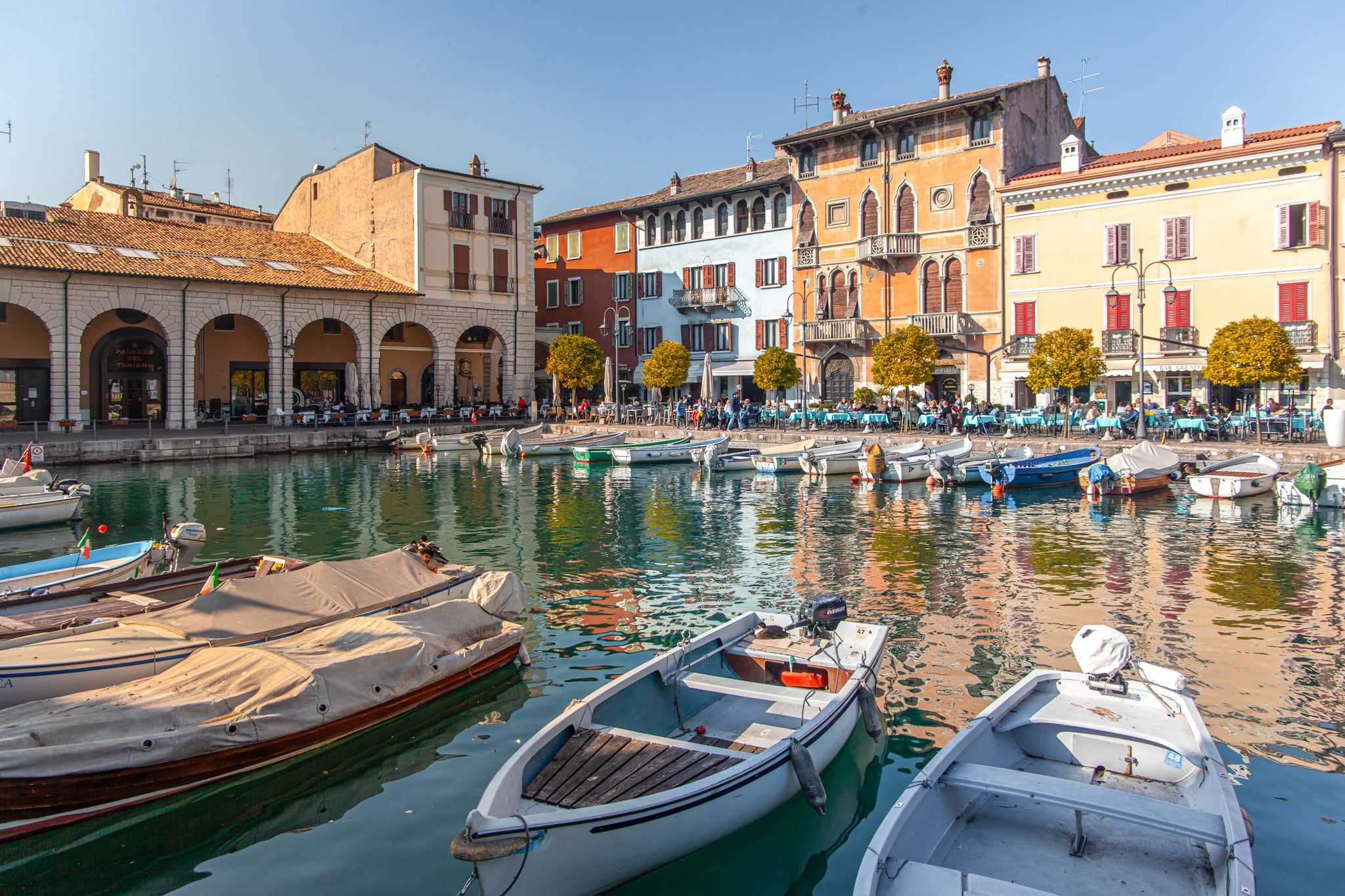
Desenzano del Garda, Lombardy
Lombardy’s handful of lakes are some of Italy’s finest glories. Fringed by pretty Italian towns and frequented by millions of tourists, they can also be as overwhelming as they are astonishing. On Lake Garda, the lake-moated castle of Sirmione, giving access to the peninsula town beyond, is one of the busiest spots. For a slightly more serene base, settle your sights on Desenzano del Garda instead. The location is perfect for exploring some of Lombardy’s best spots. Sirimione is reachable by a quick ferry ride, the pebble beaches of Manerba are a hiking trail away, and the unsung wine region of Laguna is ideal for tastings in family-run estates.
Desenzano del Garda itself is as picturesque as small Italian lake towns come. Lapped by Garda’s waters, the diminutive harbour is flanked by colourful Venetian-style architecture, well-heeled trattorie dishing-up Lombardian recipes, such as fragrant risottos, under shaded porticos, and all the gelaterias you could wish for on a lakeside stroll.
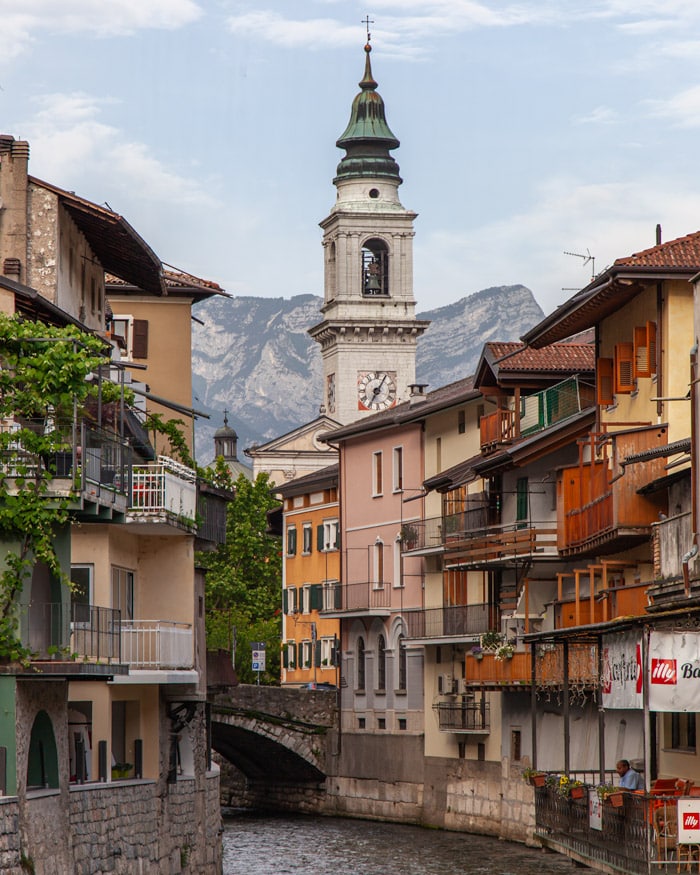
Borgo Valsugana, Trentino
Officially one of the most beautiful towns in Italy, as certified by the I Borghi più Belli d’Italia association, Borgo Valsugana is tucked away in Italy’s north. Located in Trentino, the Dolomites looming beyond, the Sugana Valley’s namesake town is a well-preserved example of mountain life. Sliced by the Brenta River, Roman roots are still visible in Sant’Orsola Church, although it’s mainly medieval layers, such as the 13th-century Castel Telvana you’ll see today. Stay in a renovated small palazzo or a welcoming agriturismo, most likely serving its own bottled wines, and appreciate the slower pace of life.
Borgo Valsugana is also an excellent base for outdoor adventures. Mountain hikes are abundant, including more unique trails through Arte Sella, an outdoor sculpture gallery. But it’s Valsugana’s pair of pristine lakes that steal the show. Levico, a tranquil, jade-tinted pool, is perfect for SUP outings followed by a thermal spa visit, while larger Lake Caldonazzo is best for fast-paced watersports. You can even get a ski lesson from a world champion here.

Read more:
Why you’ll love the lakes of Valsugana
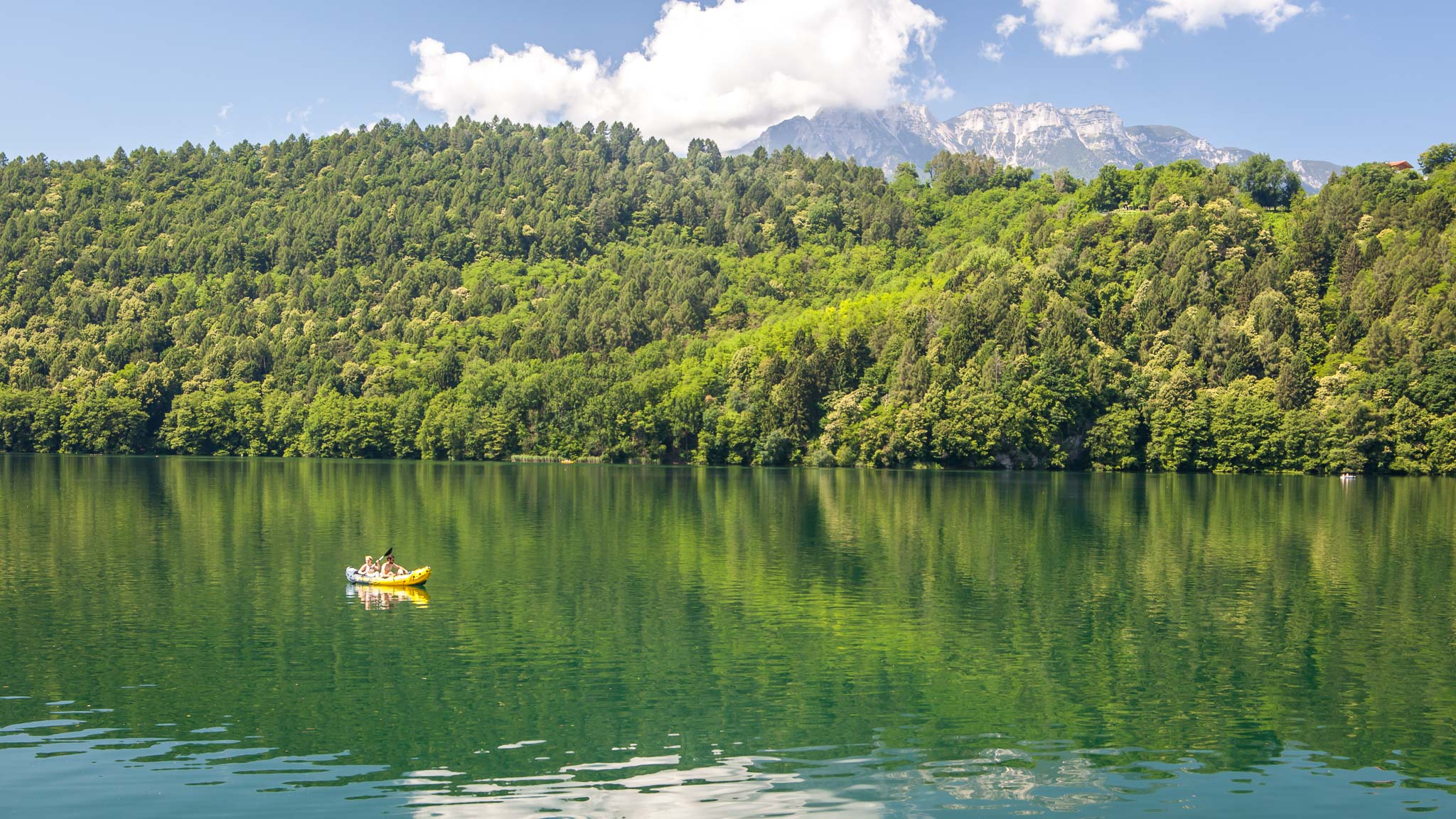
Sorrento, Campania
The Amalfi Coast, just south of the Bay of Naples, has long been the jewel in Italy’s tourism crown. Dramatic cliff-hugging villages, scented groves of canary-yellow lemons, and pebbly beaches lapped by hushed waters have seen pretty Positano painted on millions of postcards. The gateway to it all is one of Italy’s most beautiful towns, Sorrento. And while tourism has well and truly taken over the whole of the Sorrentine Peninsula, you’ll find a slightly more lived-in experience in Sorrento than the resort villages around the corner.
Long before we all flocked here for Limoncello, the Greeks and then the Romans were equally taken with the peninsula as a trading port. Nowadays, it’s an excellent base for village-hopping the Amalfi Coast or sailing across to the Isle of Capri. Still, vestiges of the past dot the town, such as the 15th-century Sedil Dominova and the Baroque Cathedral. Sure, Sorrento is missing a proper beach, but take a pew in the Villa Comunale gardens for seascape panoramas, and you’ll soon forgive this small town for its lack of sand. Come in summer, when the seasonal music festival is in full swing, and Sorrento will be soundtracked by classical concerts – timeless and blissful.
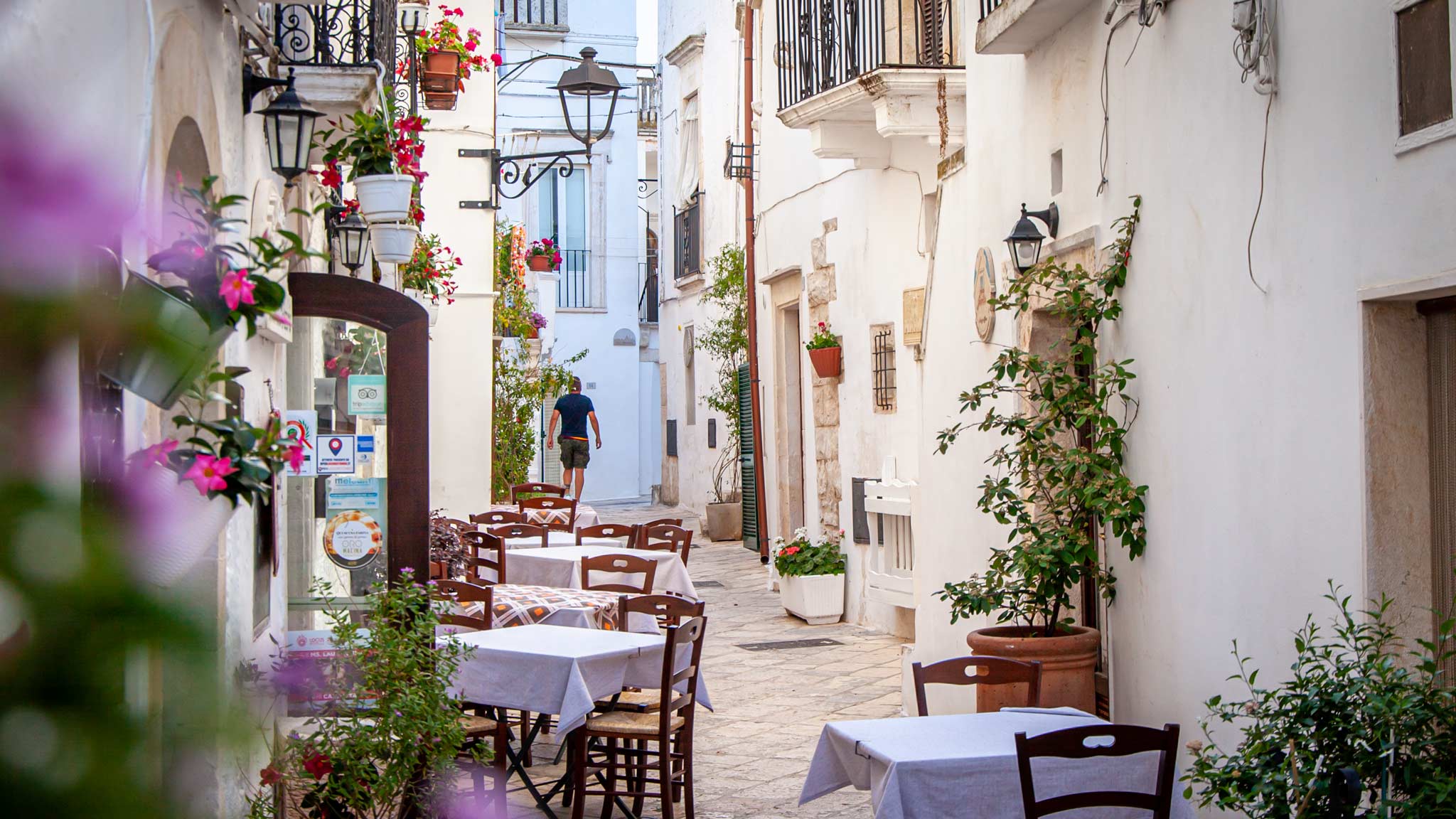
Locorotondo, Puglia
In Puglia, the heel of southern Italy’s “boot”, idyllic coastal towns reign supreme. Take a detour from the shimmering shoreline, though, and you’ll find a trove of tranquil, whitewashed towns cradled by vineyards, olive groves, and fertile farmlands. Locorotondo, named for its circular shape, is arguably one of Puglia’s prettiest.
Curved, cobblestoned streets weave through whitewashed homes, terracotta flower pots and trailing bougainvillaea adding pops of the Mediterranean palate. Settle into one of the narrow, alfresco restaurants and chow down on local specialities, such as burrata cheese, bursting with creaminess, or ear-shape orecchiette pasta, and you’ll be living out all your Italian small-town fantasies.

Read more:
One week Puglia itinerary
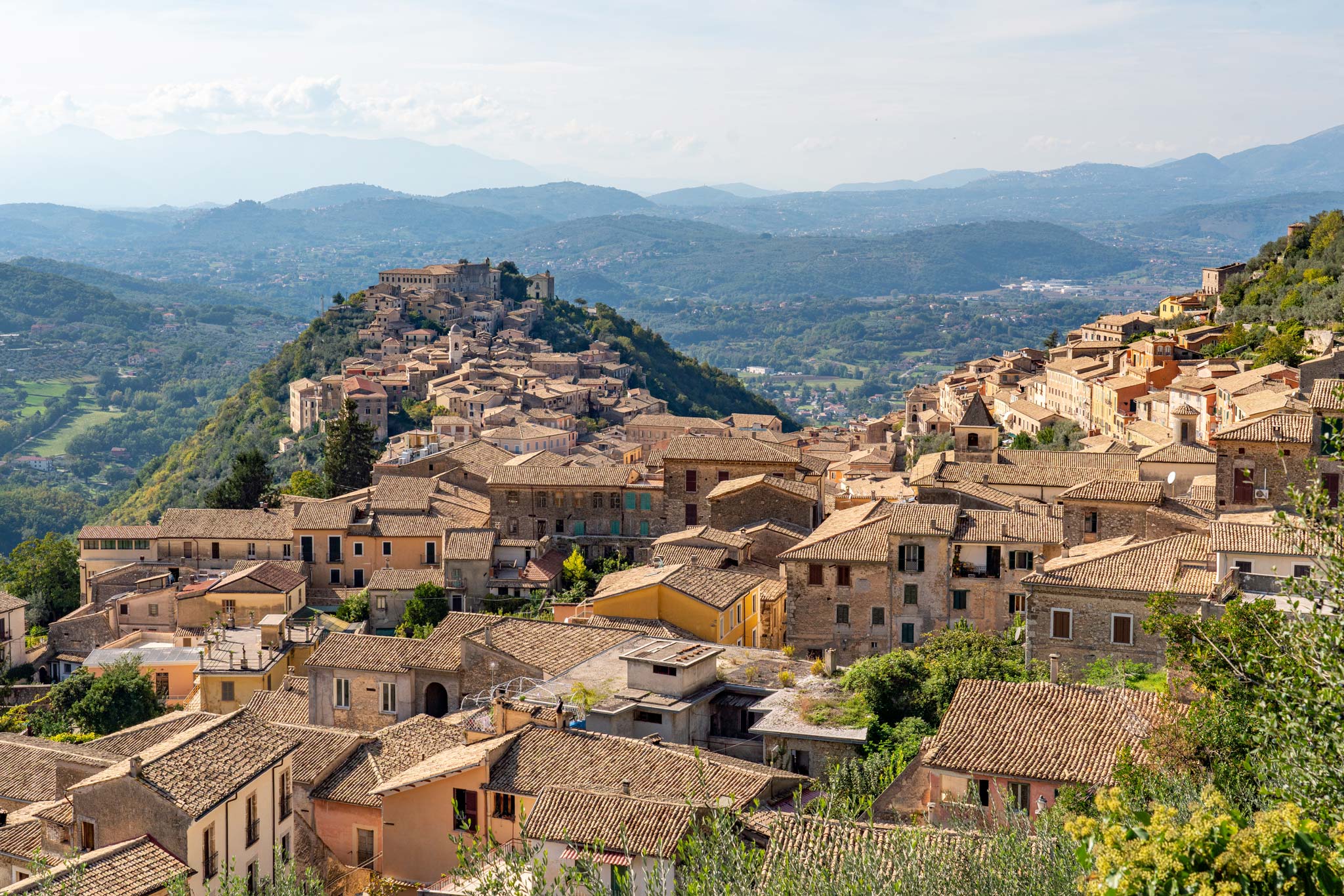
Arpino, Lazio
With Rome commanding all the attention, the rest of the Lazio region rarely gets a look in. Big mistake. Lazio’s five provinces boast some of Italy’s best small town boltholes, and Arpino is one of the best places to visit near Rome. Stretching across sloping hills in a cross-like shape, the town is as inspiring as the surrounding lush landscape of the Frosinone Valley. And inspired it has. This is the birthplace of the Roman scholar, philosopher and statesman Cicero and the Pantheon’s architect Marco Agrippa. Best of all? Here, you’ll essentially experience two small Italian towns for the price of one.
High above, the L’Acropoli di Civitavecchia is more like an adjacent village. Hemmed by mortar-free polygonal defensive walls, Civitavecchia has been inhabited since the Volscian days (around 1000 BC). Down below, the more “modern” town reveals its eras in stone walls, stacked higher and higher during the pre-Roman, Roman and medieval periods. Come in August, and you’ll be able to see the town alive for the Gonfalone of Arpino. Watching the runners balancing a terracotta amphora on their heads is just one of the unique experiences at this folklore festival.
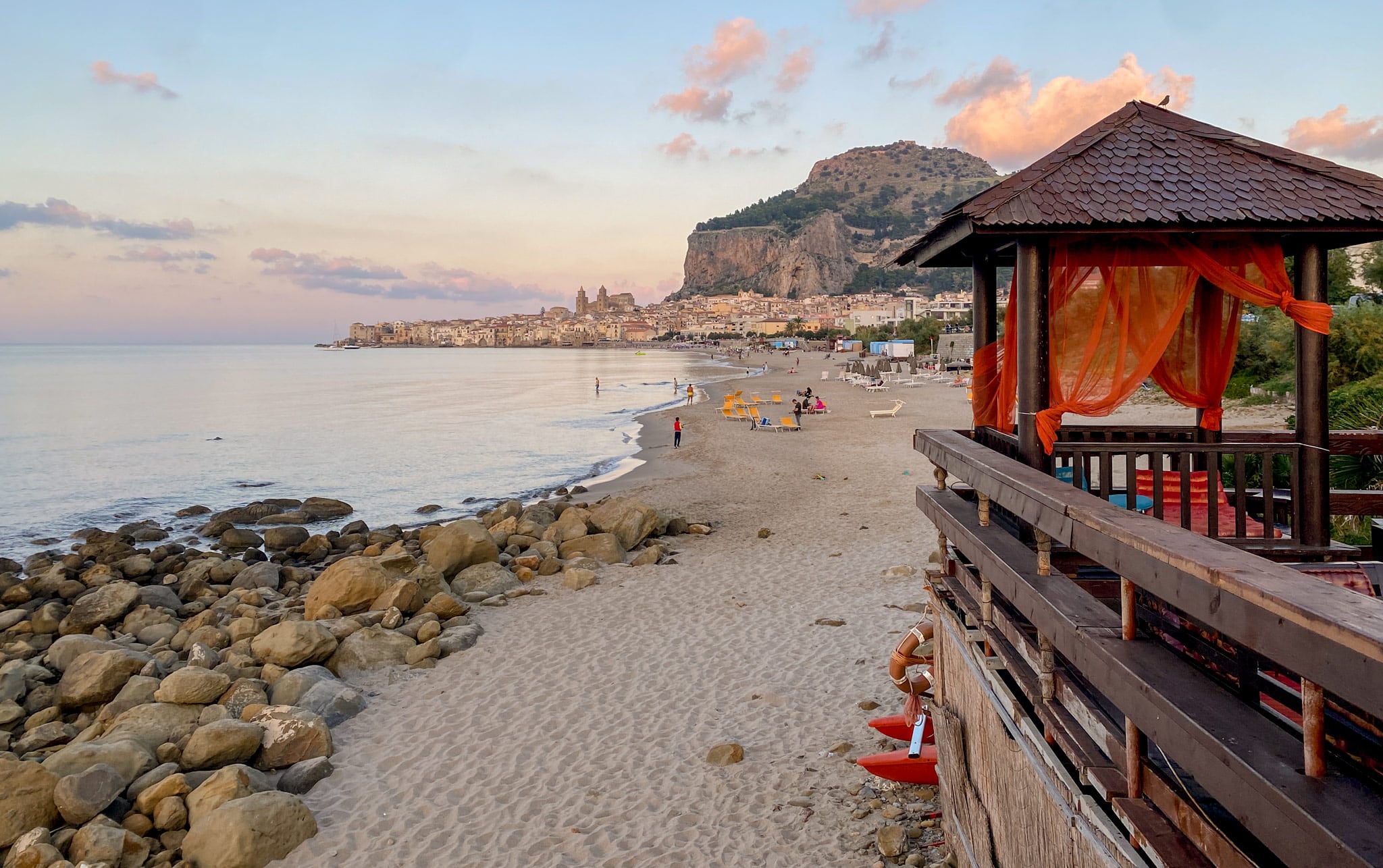
Cefalù, Sicily
Sicily has no shortage of spectacular small towns, but coastal Cefalù is the crème de la crème. Founded by the Greeks some 2300 years ago, Cefalù really blossomed during the Middle Ages. Most notable is the town’s Norman architecture, which has earned World Heritage Status. Cefalù’s Cathedral, a medieval masterpiece featuring first-class Byzantine mosaics, is the star-studded centrepiece. Like a medieval movie set, Cefalù has starred in numerous films, and you’ll feel like a silver-screen star whether you’re strolling the storied streets or ambling along the arc of butterscotch sands.
Not only is Cefalù one of the prettiest coastal towns in Italy, but it’s also a godsend for gastronomy. Sicilian food is some of the country’s most flavoursome, taking inspiration from all of the invaders, inhabitants and seafarers who have been and gone. Combine this with the bounty of fresh fish that arrives in Cefalù daily, plus some spectacular sea view restaurants, and you’ve got one of Italy’s best degustations.
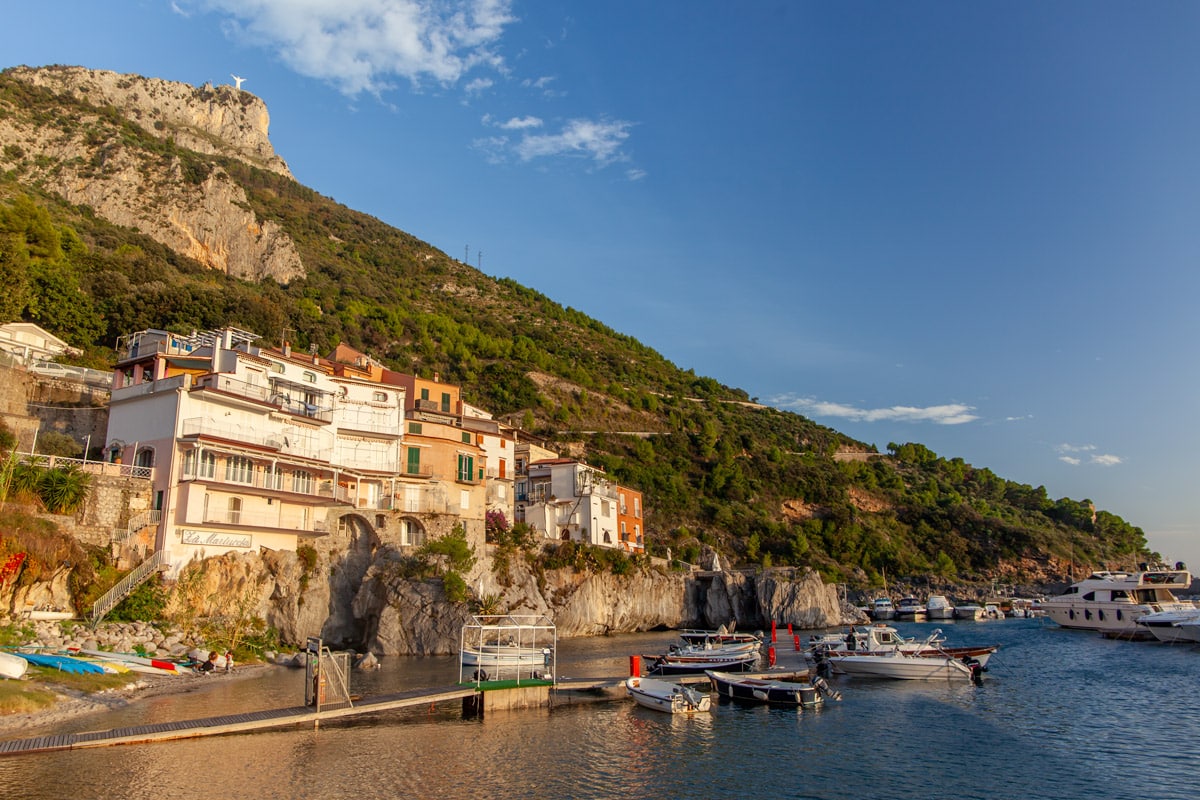
Maratea, Basilicata
Basilicata is one of Italy’s most overlooked regions. Other than Matera, an almost unbelievable city sculpted into a rocky valley, it rarely features on must-visit lists. It’s criminal but also a blessing – you’re much more likely to be holidaying with locals here. Maratea is one of those small Italian towns you come to when you want to escape it all. Think of a less glam, much more laid-back Amalfi Coast, and you’ve got the gist.
There are a few attractions to tour, such as the towering Christ the Redeemer statue staring out to the Tyrrhenian Sea and the 9th-century Basilica of Saint Blaise, but Maratea’s main charm is the laid-back coastline. While the coastal roads don’t quite compete with the Amalfi Coast’s scenery, they certainly hold their own. Take a road trip between beaches, leafy cliffs, and overlooked coves and caves accessible only by boat. By night, retreat back into the harbour for the freshest of fish. The very hands that caught it are likely drinking at the bar.

Read more:
Italy off the beaten path
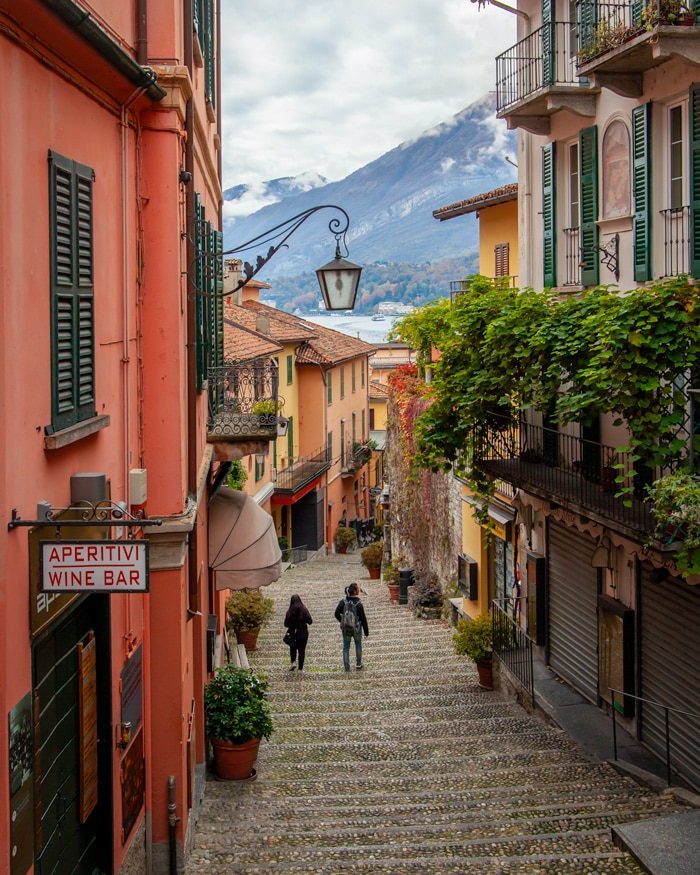
Bellagio, Lombardy
Lake Como oozes with glamour. For years, this has been a retreat for the rich and famous. George Clooney and Brad Pitt are just two of the celebrities with villas on the edge of this handsome lake, flecked with pastel-hued villages and backed by lush, low-slung mountains. At the tip of the lake’s two lower “legs”, Bellagio has long been considered the jewel in Como’s crown. Over more than a millennium, the town was sold between various private owners, keeping it both elusive and indulgent. Everything seems to take place in a lavish villa here: Villa Carlotta is a museum, Villa del Balbianello is open for unforgettable tours, and with a bit of an investment, a Villa can also be your home for the night.
Gently sloping up from the water, the core of Bellagio is a colourful medley of staircases and narrow streets. Salita Serbelloni, the town’s most photographed stairs, captures all of Bellagio’s magic. From the top, vistas of pale yellow houses, tumbling wines, cerulean waters and soaring hills beyond are enthralling. Being one of the most beautiful towns in Italy, it’s also one of the busiest. If you’re seeking a rural retreat on the water’s edge, away from the crowds, string spots like Nesso or Varenna together into a lakeside Lombardy itinerary instead. Still, with the pretty set of gardens on Bellagio’s edge, such as Giardini di Melzi, you’ll find some serene pockets on the peninsula.
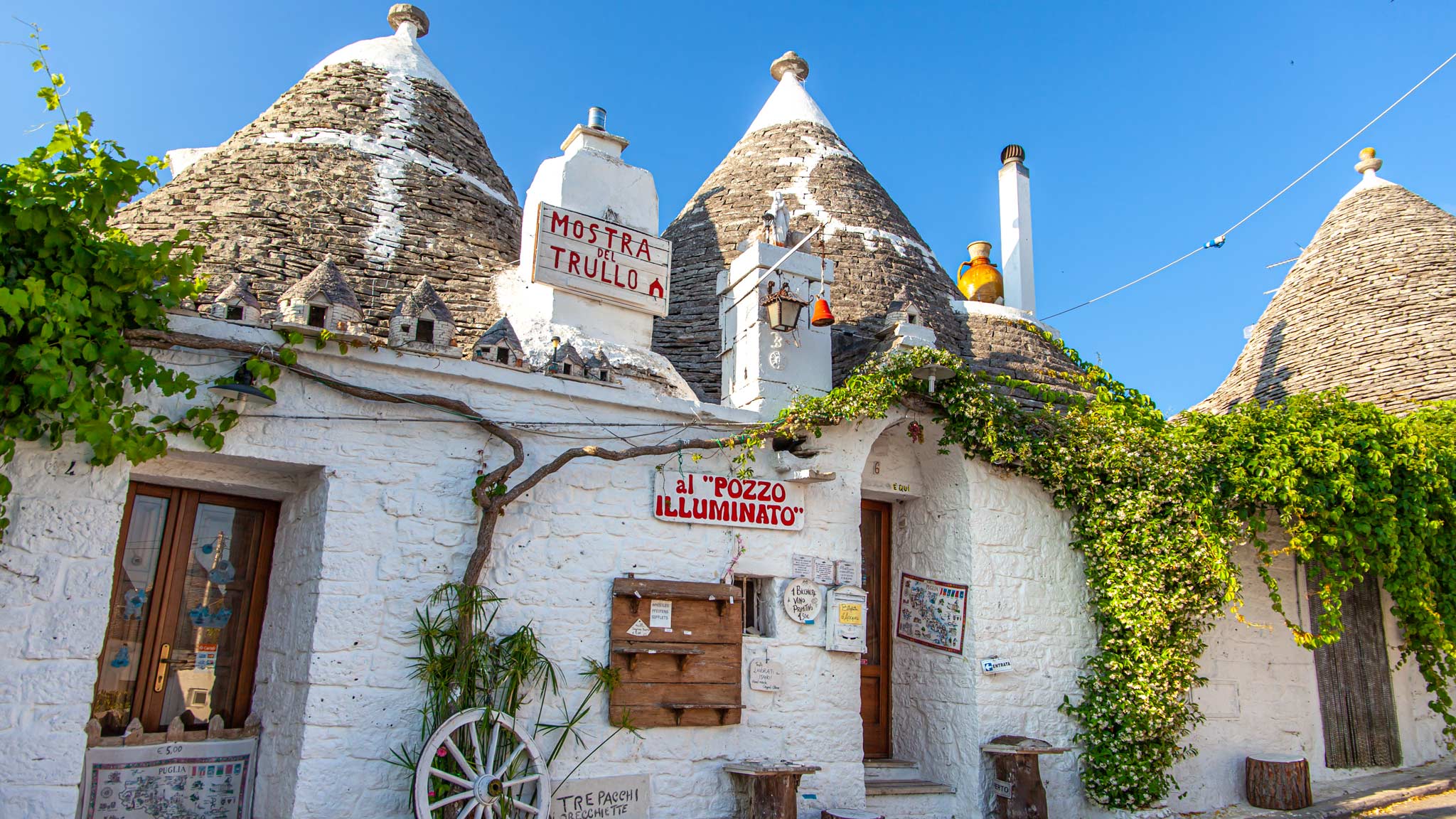
Alberobello, Puglia
In Italy’s sun-kissed southern Puglia region, the fertile Valle d’Itria is dotted with olive groves and typical trulli houses. These stone-built, circular buildings topped with conical roofs feature on every Puglia postcard, and in the small old town of Alberobello, you’ll find their greatest concentration. Here, you can sleep in a trullo, see how they would have been as typical homes in museum-style trulli such as Trullo Sovrano and Rione Aia Piccola, or enjoy a dinner under one of the conical roofs in Ristorante Trullo D’Oro.
If you’d like to spot a trullo “in the wild” rather than on these sometimes day-tripper-crowded streets, hop on a bicycle and head into the valley. Along these trails, you’ll see traditional trulli with exposed brickwork and no whitewashed facade intertwined with olive groves and citrus trees.

Read more:
Things to do in Puglia
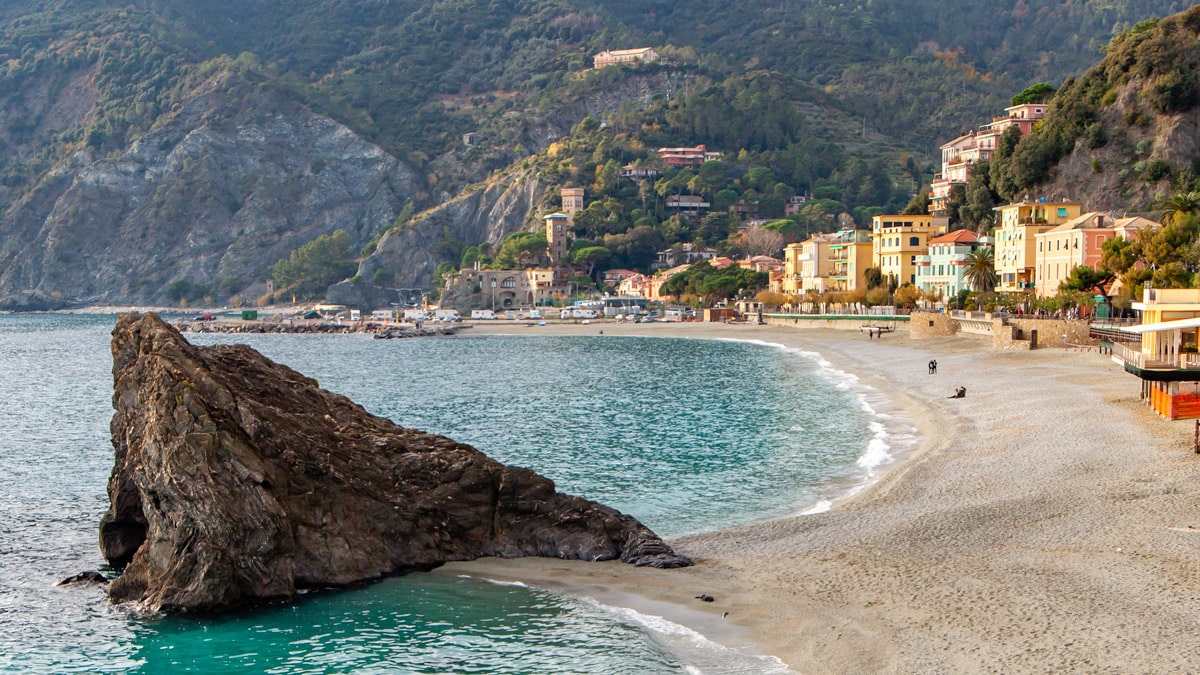
Monterosso al Mare, Cinque Terre, Liguria
Along the North Ligurian Coast, also known as the Italian Riviera, the five villages of Cinque Terre have long enchanted travellers. Linked by slow trundling trains and epic trails overlooking tumbling vineyards and the Mediterranean beyond, it’s a timeless setting of settlements at the base of steep verdant slopes. While all of the five lands (the direct translation of Cinque Terre) are technically fishing villages, tourism has seriously reshaped the narrative here. Especially in Monterosso al Mare, the westernmost of the handful, which feels like a small town these days rather than a tucked-away village.
Is it the prettiest of the five? Not really. But Monterosso al Mare does stand out for its sweep of sand, something lacking in the other four. Thankfully, the town’s medieval character still shines, and the cluster of narrow streets, historic buildings and the Aurora Tower, which juts into the ocean while doubling as a marker for where the old and new parts of town meet, make it as old-world as the rest. For me, the best time to visit Cinque Terre is in the low season, when you’re much more likely to experience silence by night rather than a sea of selfie sticks. And off-season is when Monterosso shines, as the bars and restaurants in some of the smaller villages shutter in winter.
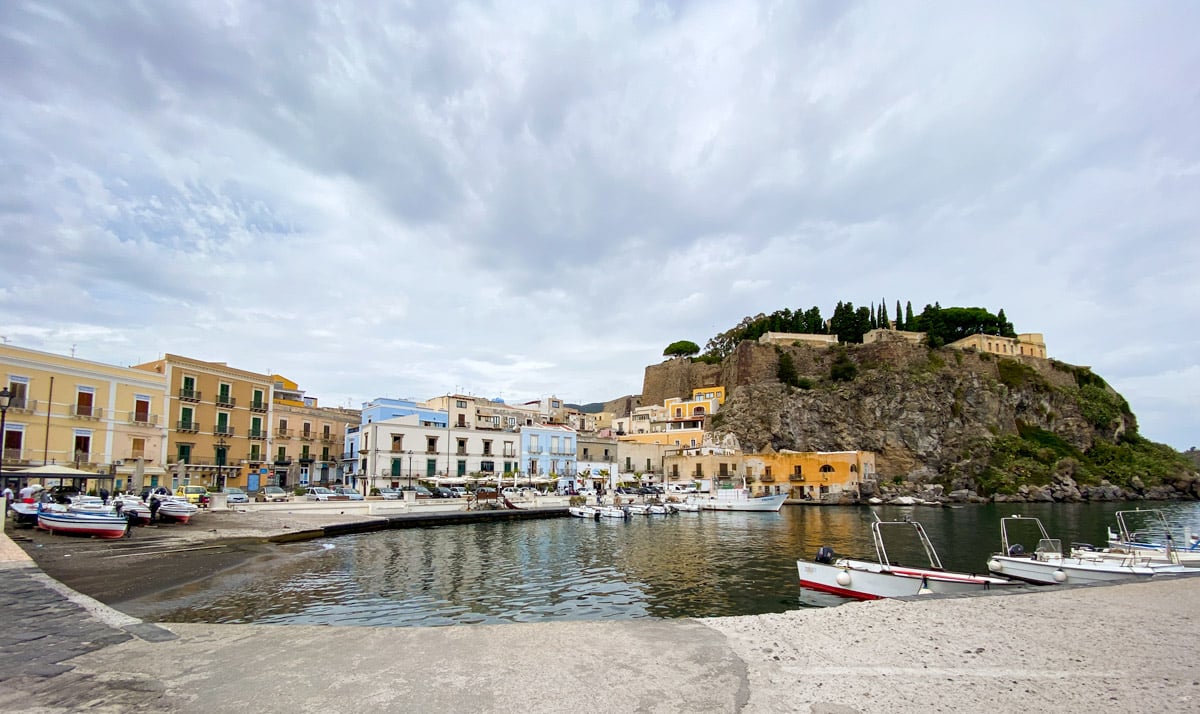
Lipari, Sicily
The Aeolian Islands, a set of seven serene – if you ignore the bubbling volcanic activity of Stromboli – isles off Sicily’s northeast coast, host some of the more offbeat towns in Italy. San Pietro on Panarea and Vulcano Port, with its sulphur stink, are two of my favourite small towns on this archipelago. But it’s the town of Lipari, on the islands of the same name, that earns my recommendation. Amongst the narrow streets of the historical centre, you’ll find Mediterranean living at its best. The freshest of seafood (try local stuffed octopus with a glass of the island-produced Malvasia) spills across the al fresco tables of laid-back osterias. Luminous bougainvillaea falls down the fronts of whitewashed buildings. And the town’s history unfurls in the Greek and Roman exhibits of the Museo Archeologico.
Once you’ve clambered up the steep cobblestone streets, you’ll reach the Castle of Lipari. These Spanish-built medieval fortress walls, perched atop a volcanic rock, afford some of the best views in town. Inside, you’ll find more historic discoveries, ceramics, and the Church of Santa Caterina. If you want Sicily in miniature, you’ll find it here.

Read more:
Best islands to visit
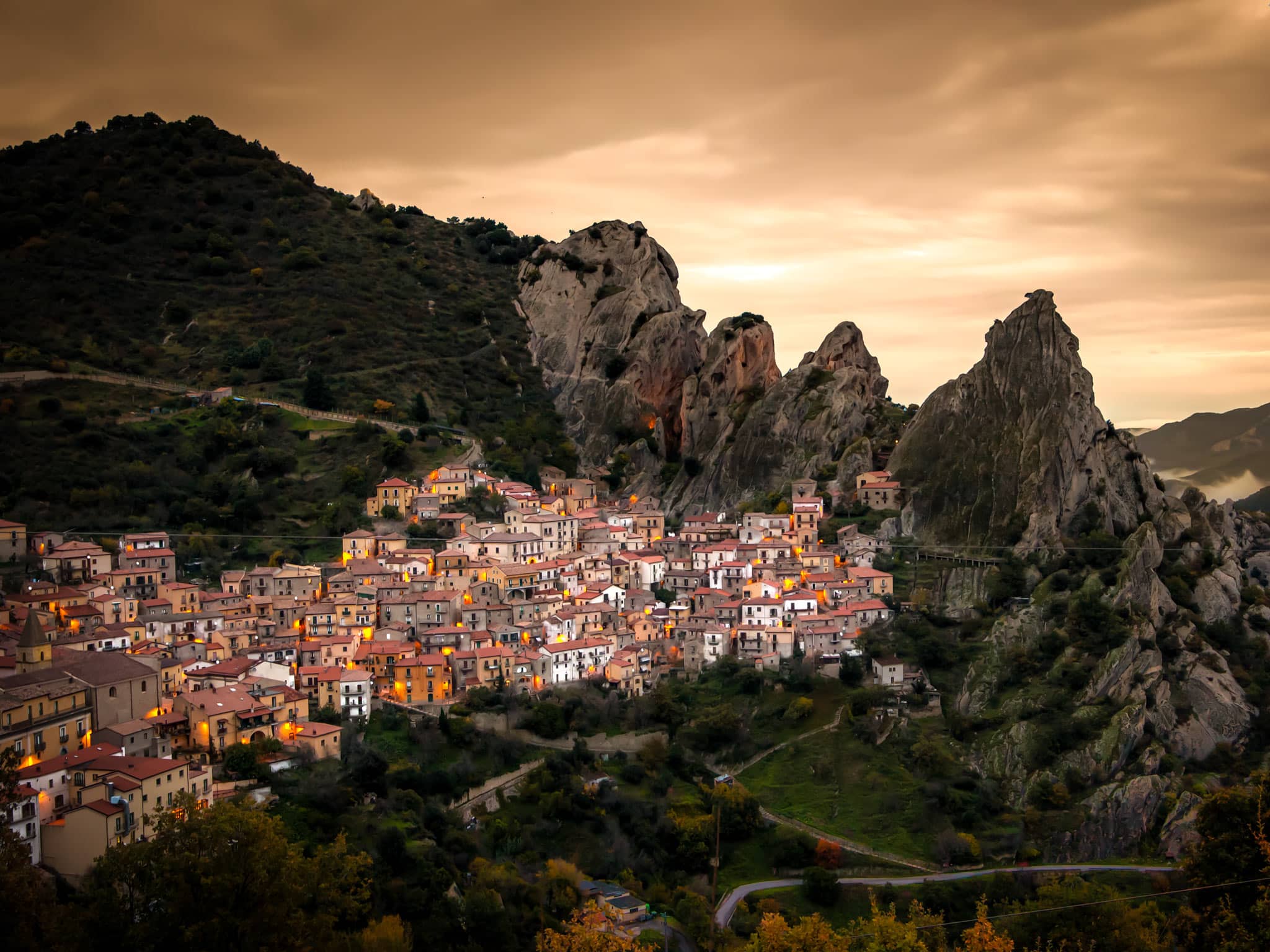
Castelmezzano, Basilicata
One of the most beautiful towns in Italy, Castelmezzano is that dreamy mountain getaway. Perched against the backdrop of the Dolomiti Lucane, a set of saw-toothed peaks that dominate the landscape, the cluster of ochre roofs, bathed in orange street lights at night, are truly cinematic. This is a town to come to for mountain hikes and a countryside retreat. Stay a few nights in this 10th-century settlement, and you’ll soon discover all the secrets of Castelmezzano’s side streets.
Castelmezzano isn’t the only small Italian town shrouded by these mountains, though. Here, you get two for the price of one. Pietrapertosa, the “twin” across the way, is linked by the Angel’s Flight, a zipline that will whisk you through the air to the second of the peak-snuggled towns. Once you’ve had your fill of rural Italian living, continue to Basilicata’s most beguiling city, Matera, a magical land of caves, ancient underground living, and streets that tell the stories of poverty, disease and now, restoration.
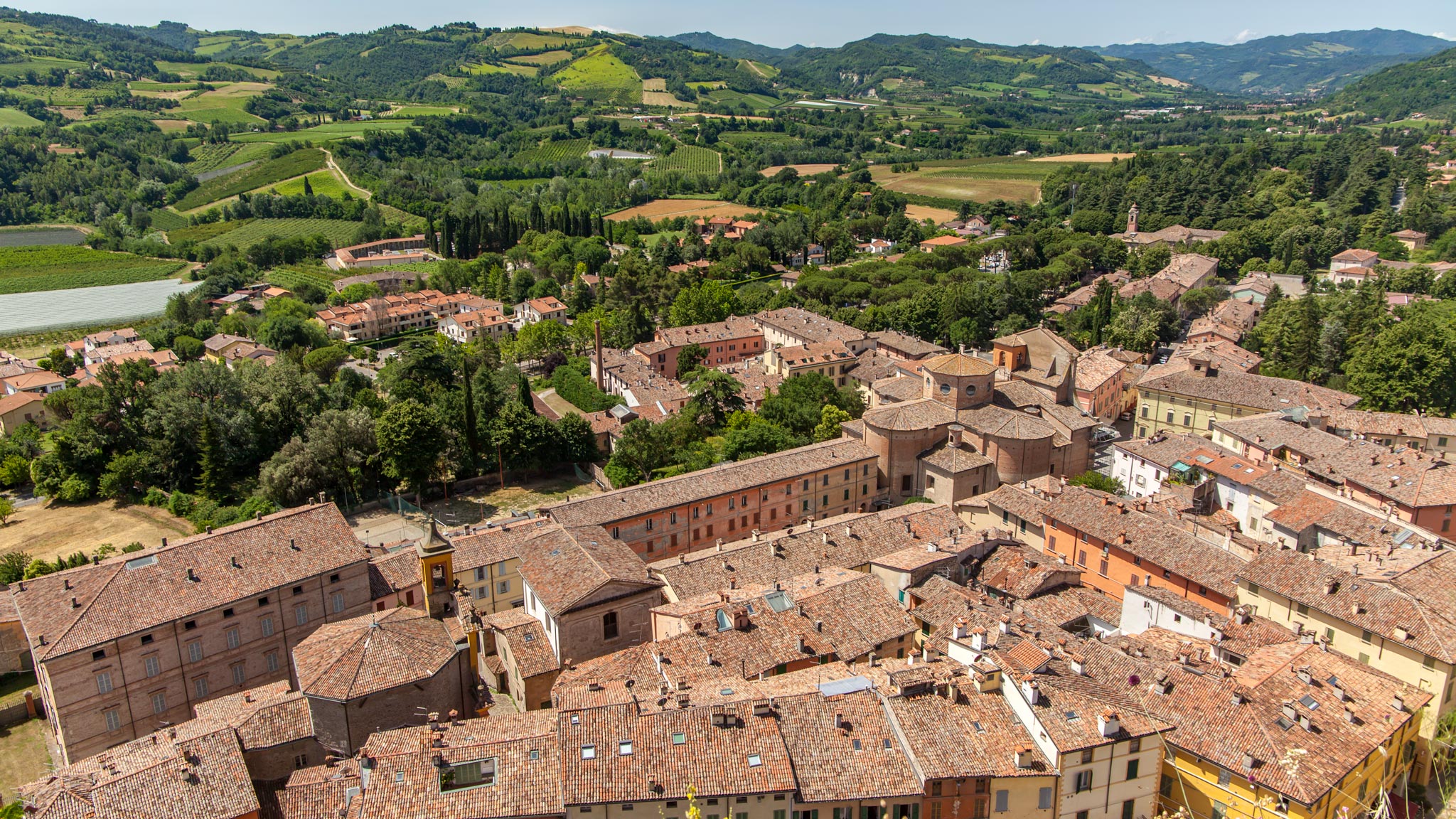
Brisighella, Emilia Romagna
In Emilia Romagna, best known for the foodie cities of Bologna, Parma and Modena, you’ll find Brisighella, one of the prettiest small towns in Italy. I could wax lyrically about this place for days. Arriving here felt like stepping into an Italian movie set – castles stand above vineyards, a clocktower surveys the lush valley, and terracotta-roofed homes exist in a trance-like state.
Set around three hills, each crowned with a landmark – a clocktower, a castle and a church – there are plenty of easy trails which will take you to the main sights. Vestiges of Brisighella’s medieval past are very much evident, especially in the Via degli Asini, a half-timbered, stone-floored passageway. And as with much of Emilia Romagna, local flavours are in abundance, with small-batch wines and excellent, if unsung, olive oils of particular note. Once you’ve bathed in Brisighella’s glory, head into the mountains of Parco Carnè or the nearby old quarry caves, where live music performances are held underground in summer.

Read more:
Things to do in beautiful Brisighella
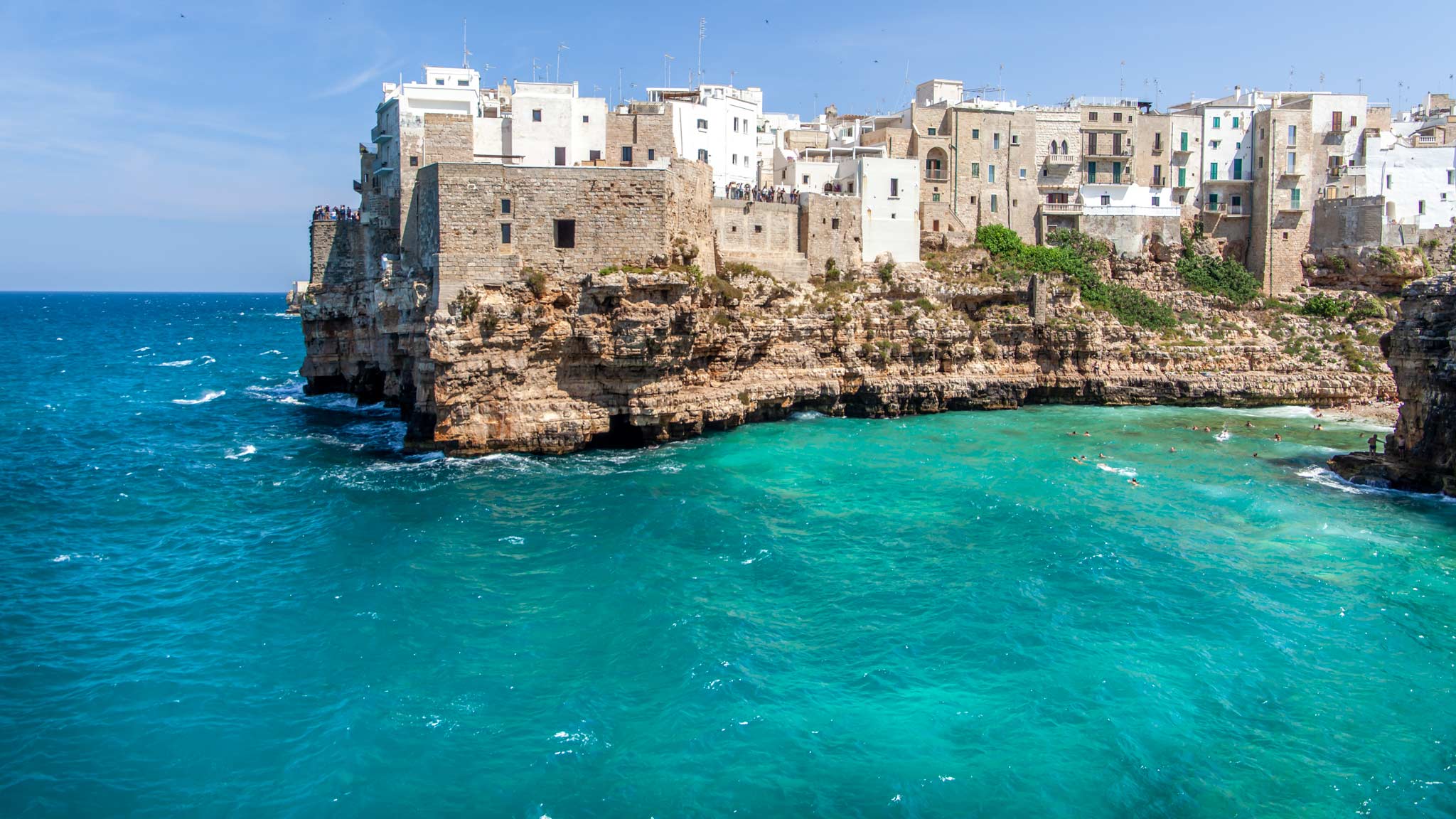
Polignano a Mare, Puglia
Puglia is regarded as one of Europe’s best beach destinations and has pretty seaside Italian towns aplenty. Even if some shorelines are pebbly rather than sandy, this does little to put off troves of Northern Italians flocking to the south every year – and Polignano a Mare is a popular choice. Chances are, you’ve seen this striking whitewashed village, which crowns cyan waters atop near-vertical limestone cliffs, on Instagram. It’s Puglia’s poster child. The little main beach looks even better from a viewpoint above, although it can get crowded in summer. Still, with an abundance of beaches on the peripherals, you don’t have to travel far for a more private spot of sand. Better still, hop on a boat tour and explore the caves to see some of Puglia’s best features.
Inside Polignano a Mare’s maze of streets, you’ll find everything that makes Puglia so delectable. Narrow lanes, flanked by whitewashed and sandstone buildings, weave past little boutiques selling locally crafted ceramics. Window-style restaurants prepare stuffed Puccia Salentina sandwiches. Alfresco restaurants serve plump red prawns and cuttlefish. And gelato parlours adorned with ceramic flower pots dish out jade-hued pistachio scoops. There isn’t a long list of attractions to tick off – but perhaps that’s what makes this Italian town the perfect seaside holiday.
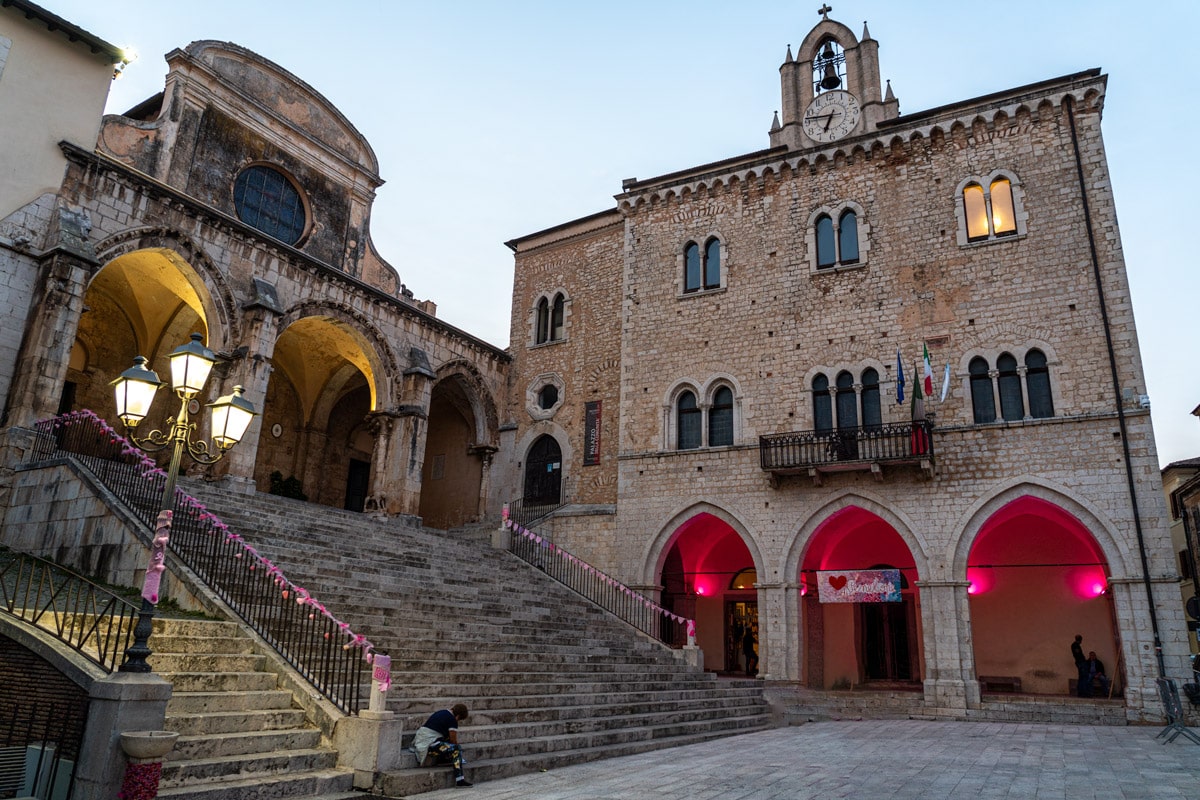
Priverno, Lazio
Travel around an hour south of Rome and leave the crowds in your wake as you head deeper into Lazio. Priverno is one of Italy’s lesser-visited small towns, but it won’t disappoint those seeking archaeological finds. The mammoth discovery of the Roman city of Privernum, where archaeological digs continue, is nearby. In Priveno’s city museum, you’ll find these incredible mosaics, statues, artefacts and other discoveries, all curated and catalogued by humble Paula (say hey from me!). Across the plaza from the museum, a grand staircase leads into the Cathedral, where St. Thomas’s skull has put Priverno on the pilgrimage map. Around the town, medieval architecture unfurls at every corner, making the lack of international tourists all the more surprising. Come for the annual medieval festival, and you’ll see reenactments of how life once was.
Just up the road is one of Italy’s smallest villages, centred around the Gothic, 12th-century Abbey of Fossanova, where St. Thomas spent his final days. This is Italy’s oldest Cistercian monastery, and it remained closed to the public, other than pilgrims, for centuries. Nowadays, you can enter the imposing, if simply decorated, Abbey before seeing more archaeological discoveries in the neighbouring museum. The provincial table doesn’t disappoint either, with buffalo produce, such as mozzarella and meats, treasured Orsini Olive Oil, and Chiacchietegli di Priverno (Priverno’s violet broccoli) padding the menu.

Read more:
These are Europe’s best hidden gems
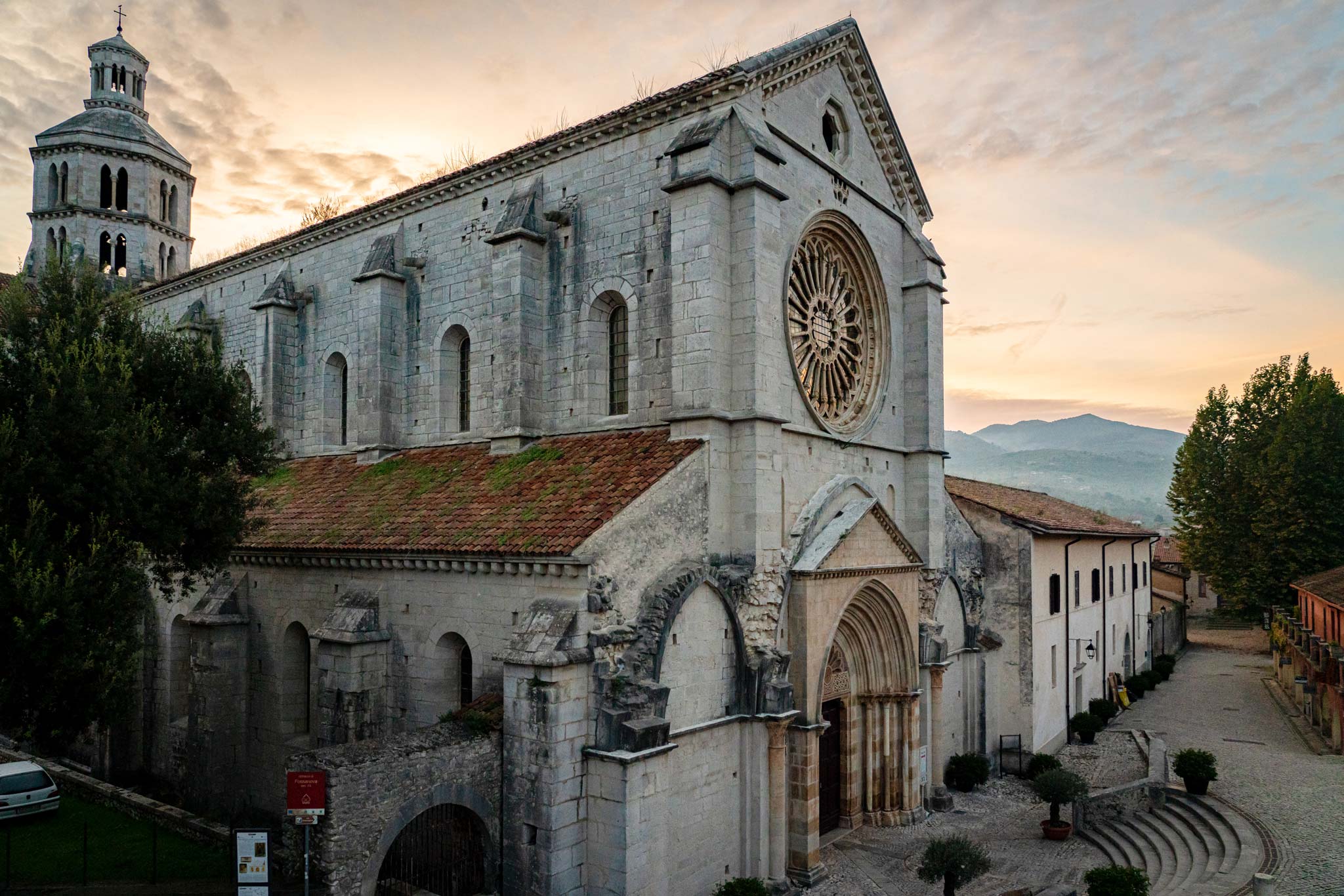
Orvieto, Umbria
Perched atop a volcanic plateau, Orvieto is one of Umbria’s most beautiful medieval towns. In this part of Italy, Etruscan history is writ large, making Orvieto much older than its Middle Ages architecture conveys. Yet it’s a different story when you head underground. Take a tour of the caves, tunnels and other subsurface wonders, and you’ll start to get an idea of how advanced the Etruscan civilization was nearly 3000 years ago.
Back above, the hulking and highly detailed Duomo di Orvieto is the star. Honestly, it should be famous the world over for its magnificent frescoes and detailed facade. But all across the storied streets, you’ll find vestiges of the past, which particularly pop during Oriveto’s numerous cultural events. If you’re seeking a Tuscan-style retreat but want fewer crowds, Umbria is much more than a consolation prize.
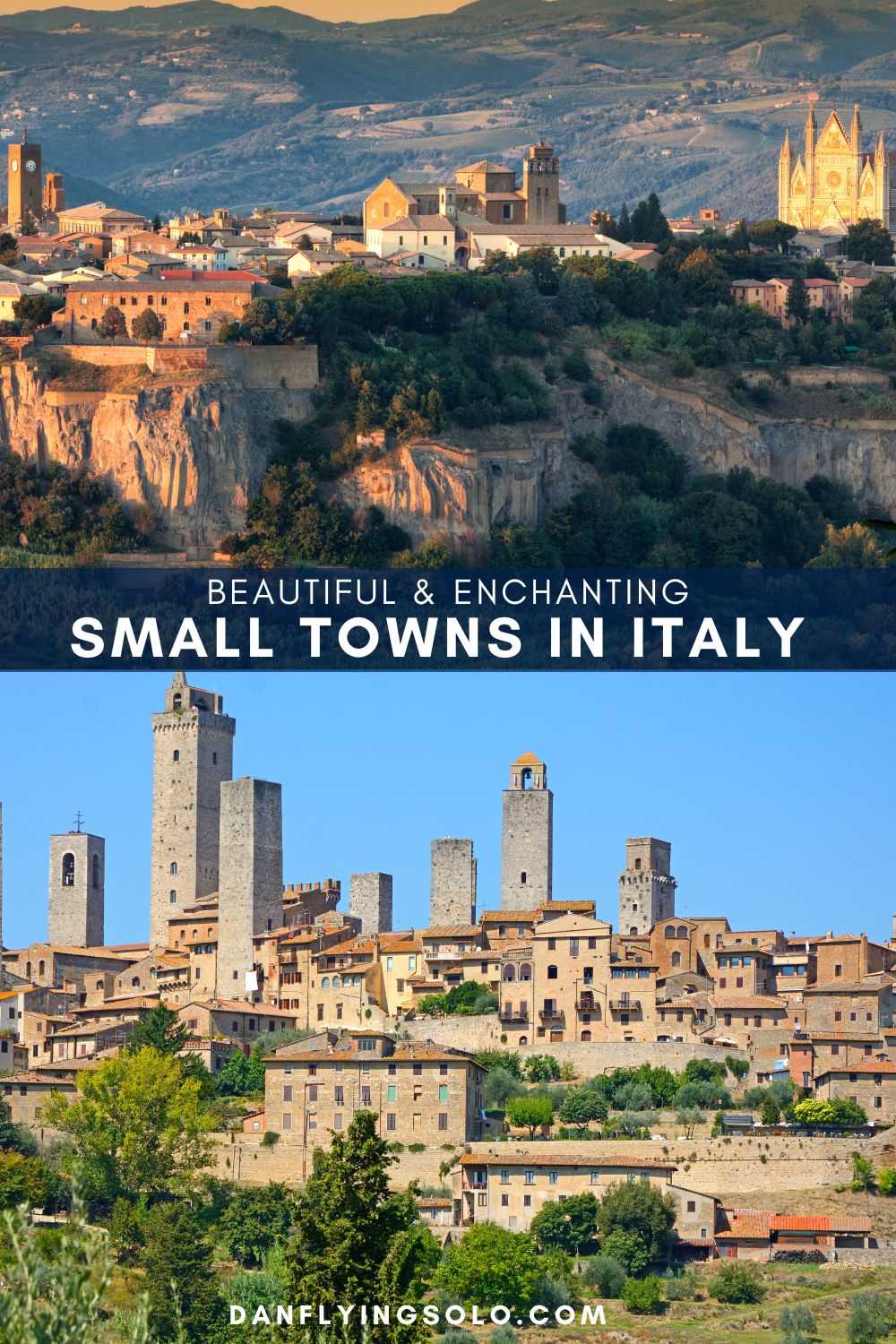
San Gimignano, Tuscany
Speaking of Tuscany, I can’t write a list of the most beautiful small towns in Italy and forget the forever charming settlements that dot the region’s beloved rolling hills. Picking just one is mission impossible, but the UNESCO-listed Historic Centre of San Gimignano is famed for good reason. Long a pilgrimage stop on the Via Francigena – a centuries-old, multi-day, cross-country trail that traverses many of the above-mentioned towns – San Gimignano has been welcoming hoards long before it rose to tourism fame.
Nowadays, it’s the well-preserved medieval architecture, especially the heaven-reaching towers that dot the town, and the unimaginable interior paintings of the Collegiate Church of San Gimignano, that pull in the crowds. Settle into Tuscan life at an out-of-town countryside stay, enjoy mornings strolling through the town’s time capsule before the day-trippers arrive, and spend your long lunches sipping the local, crisp Vernaccia wine – is there really any better way to appreciate Italy’s beautiful small towns?

Read more:
Underrated European cities to visit




Leave a Reply
Want to join the discussion?Feel free to contribute!